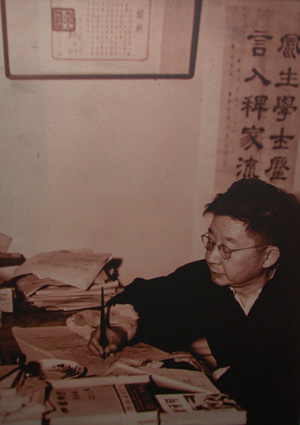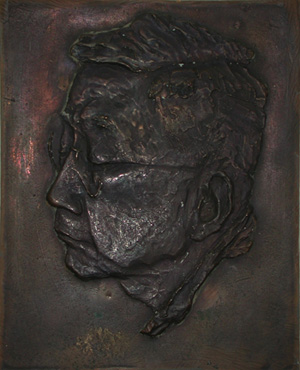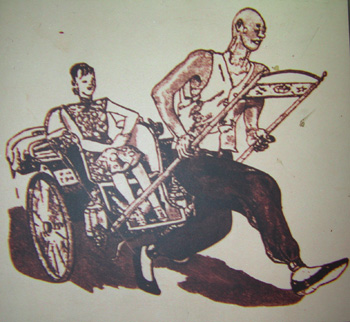Silk Road, 1999
Walking On the Wild Side
The Yangtze River, China’s main artery, has been the backdrop to much of the country’s important history and has influenced politics, life and culture.
By PAUL MOONEY in Beijing
Every day, a small but steady steam of people turn off Beijing’s bustling Wangfujing Street near One World Department Store and head north along a dusty alley optimistically called Fengfu Hutong, or Abundance Lane. Their destination is No. 19, a nondescript traditional courtyard house. A simple sign with gold lettering at the entrance identifies the structure as the Lao She Memorial House.
 The house and memorabilia on display are unimposing compared to other memorial houses in Beijing—an indication of the simple life that Lao She led. Visitors come here not for vicarious enjoyment of gentility, but to show their respect for Lao She’s genius and to express their sorrow over how it was extinguished.
The house and memorabilia on display are unimposing compared to other memorial houses in Beijing—an indication of the simple life that Lao She led. Visitors come here not for vicarious enjoyment of gentility, but to show their respect for Lao She’s genius and to express their sorrow over how it was extinguished.
Lao She was born in Beijing in 1899, the son of a Manchu soldier killed fighting the Western army that invaded Beijing during the Boxer Rebellion in 1911. He grew up in poverty and worked as a teacher for several years, before moving to London in 1924. During his five years there, he taught classical Chinese and modern Chinese conversation and composition at the University of London’s School of Oriental and African Studies. He also wrote a series of comic novels.
Lao She returned to China in 1930, taught in Shandong Province for seven years and, one year later, married Hu Jieqing, an artist. In the 1930s, he wrote a series of plays to rally support for the war of resistance against Japan.
In 1946, Lao She moved to New York, where he stayed for four-and-a-half years, teaching modern Chinese literature. In December 1949, immediately after the Communists came to power, he returned to China at the urging of Premier Zhou Enlai and moved into this house.
Over the years, he wrote more than 40 novels and numerous essays. His most famous novel is Rickshaw Boy, the tragicomic tale of a rickshaw puller’s life in an uncaring society. Another popular work is Teahouse, which describes the changes in China from the overthrow of the Qing Dynasty in 1911 to the end of the Nationalist period, through the eyes of the patrons of a Beijing teahouse. Many of his works have been made into plays, films and TV series.
The modest Lao She relished his role as storyteller, an art in which he excelled. It is no surprise that he admired the works of Mark Twain, Charles Dickens, and Joseph Conrad.
“Some critics have said Lao She was the Mark Twain of China because of his unusual insight into the subtle nuances of people,” writes an American expert on Lao She. “He saw humour in the everyday experiences of life. He could laugh at himself and get points across with humour, often tinted with his own brand of satire. No writer has ever put into words the language, thoughts, customs and lifestyle of Beijing and its people as has Lao She.”
As soon as one enters the small courtyard, the sounds of the city vanish, and one feels transported to some quiet mountain retreat. If you are lucky, you will be greeted at the door by Shu Ji, Lao She’s 66-year-old daughter, who has edited many of her father’s works, and who today oversees this small museum, where she lived for 47 years.
 The Lao She Memorial House opened in February, on the centenary of the writer’s birth. The family long wanted to turn the 100-plus-year-old house, which was designated a municipal historical site in 1984, into a museum, but funds to repair the decaying structure were lacking.
The Lao She Memorial House opened in February, on the centenary of the writer’s birth. The family long wanted to turn the 100-plus-year-old house, which was designated a municipal historical site in 1984, into a museum, but funds to repair the decaying structure were lacking.
“When I lived here, people knocked at the door every day, wanting to come in for a visit,” recalls Shu. “People came from provinces all over China, but the house was so run down, we were reluctant to let anyone in.”
With contributions from the Beijing municipal government and organizations in Japan, the dream was finally realized. In 1997, Shu, the last family member to live here, moved out, and extensive refurbishing began.
“Although it’s a small courtyard house,” the daughter points out, “it encompasses great emotions.”
The house is made up of several parts. The children’s bedrooms on the east and west sides have been turned into display rooms. The living room and adjoining bedrooms of Lao She and his wife remain much as they appeared when the family resided here in the 1960s.
Visitors can view various rough drafts of Lao She’s novels, lecture notes in Chinese on the German philosopher Nietzsche, and a class schedule from the School of Oriental and African Studies listing Lao She’s courses. Letters he wrote to an otherwise unidentified Mr. Lloyd in the United States display impeccable English (his novel The Two Mas was originally written in English and later rewritten in Chinese). In one letter he describes how much he enjoyed working with Ida Pruitt on the English version of a novel.
“She has, however, her shortcomings,” he adds in a flowing longhand. “She would, for example, insist to keep the Chinese flavor as much as she can, which makes her sometimes write broken English.”
Another letter tells of his delight after coming up with the English title for another novel, Yellow Storm, while walking in the woods with Pruitt at her brother’s house in Pennsylvania.
Lao she’s bookshelf holds the works of his favourite authors, the Everyman’s Library edition of Stendahl’s The Red and the Black, Mark Twain’s The Prince and the Pauper and works by Charles Dickens, Evelyn Waugh and Graham Greene. Photographs show Lao She meeting Mao Zedong, Zhou Enlai and famous Peking opera stars, writers and artists. There are also stills from the many movie and stage adaptations of his novels, and copies of his works translated into English, Japanese, Korean, Russian, German, French and Italian. Also interesting are the cartoons, caricatures and woodblock prints depicting scenes from his many works.
One black-and-white photograph shows a doting Lao She smiling as his granddaughter, Shu Yue, sits on his lap. The photo was taken in January 1966, just eight months before his death. Nearby is a photo of angry-looking Red Guards –radical young students and workers organized as the shock troops of the Cultural Revolution (1966-1976)—burning Peking opera costumes and paraphernalia before the gates of the Confucian Temple.
The caption explains that Lao She and 30-odd prominent artists, labeled “literati reactionaries” and “capitalist-roaders”, were dragged to this spot on August 23, 1966. They were insulted, beaten with opera props and, with blood running down their faces, forced to kneel in front of the raging fire. Meanwhile, Red Guards raided Lao She’s house, seizing books and other possessions.
Lao She, who was targeted probably because of his Western connections and love of traditional Chinese culture, reportedly was “confrontational” with the Red Guards and so was taken back of his office at the Cultural Affairs bureau for further beatings. He was ordered to report back the next day for further “struggle e sessions”.
His wife took him home in the early morning hours, wiping the blood from his face and badly bruised body. “He ate and drank nothing,” recalls the woman, now 95, in a recent account. “I sensed something terrible would happen.”
Lao She rose early and, before leaving the house, went to say goodbye to his little Shu Yue. He did not go to the office, further enraging his Red Guard tormentors. Accounts say he went instead to Taiping Lake, where he spent the day sitting on a park bench. In the evening, he picked up a heavy stone and disappeared below the waters of the lake. The calendar on his desk remains open to Wednesday, August 24, 1966.
Shu prefers to remember happier days. She smiles as she recalls frequent visit by Peking opera greats Mei Lanfang and Ma Lianliang, painters Fu Baoshi and Li Keran, and fellow author Zhou Zuoren. They came to this simple house, she says, to eat, drink, chat and enjoy the chrysanthemums in the courtyard. There were also visits to the nearby Capital Theatre for plays, to the Jinxiang Theatre for Peking opera, and to the bustling Dong’an Market (recently redeveloped as the New Dong’an Shopping Centre).
 The daughter recalls one night when Premier Zhou made an unannounced visit to the house around dinner time, sending the family scurrying for groceries to prepare for one of the nation’s top officials.
The daughter recalls one night when Premier Zhou made an unannounced visit to the house around dinner time, sending the family scurrying for groceries to prepare for one of the nation’s top officials.
As Lao She’s works are today included in Chinese middle-school and high-school curricula, the museum attracts many teachers and young students. One recent morning, the sun-filled courtyard is crowded with several dozen high-school teachers, who stand or sit in a circle around Shu, taking notes as she lectures on her father’s writings. An old man enters the courtyard, a young woman supporting him as he walks slowly around the displays. A teenager and his uncle study the various items on display and chat with Shu.
“Beijing people cherish the memory of my father,” says Shu, adding that the Beijing flavour of his writing strikes a special chord with local residents.
But it is not just Chinese who make the pilgrimage to this shrine. Lao She has an especially strong following in Japan.